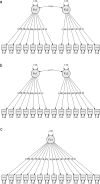Detecting anxiety and depression among people with limited literacy living with chronic low back pain in Nigeria: adaptation and validation of the hospital anxiety and depression scale
- PMID: 33962689
- PMCID: PMC8105915
- DOI: 10.1186/s13690-021-00586-4
Detecting anxiety and depression among people with limited literacy living with chronic low back pain in Nigeria: adaptation and validation of the hospital anxiety and depression scale
Abstract
Background: The Hospital Anxiety and Depression Scale (HADS) is one of the most popular measures of anxiety and depression. The original HADS is mostly used in Nigeria precluding people with limited literacy. This study aimed to cross-culturally adapt and psychometrically test the HADS for rural and urban Nigerian Igbo populations with chronic low back pain (CLBP) who have limited literacy.
Methods: The HADS was forward translated, back translated, and appraised. Face and content validity was ensured by pre-testing the translated measure among a convenience sample of twelve rural Nigerian dwellers with CLBP. Reliability utilising Cronbach's alpha, intraclass correlation coefficient, Bland-Altman plots and minimal detectable change were investigated amongst a convenience sample of 50 people living with CLBP in rural and urban Nigerian communities. Construct validity testing involving correlations between Igbo-HADS and Roland Morris Disability Questionnaire measuring self-reported back pain-specific disability, World Health Organisation Disability Assessment Schedule assessing generic self-reported disability, Fear Avoidance Beliefs Questionnaire measuring fear avoidance beliefs, and eleven-point box scale assessing pain intensity, and exploratory factor analysis (EFA) and confirmatory factor analysis (CFA) among a random sample of 200 adults with CLBP in rural Nigerian communities were conducted.
Results: Idioms and colloquialisms were difficult to adapt. Internal consistency was good (α = 0.78) and acceptable (α = 0.67) for anxiety and depression subscales respectively. Intraclass correlation coefficients were very good (ICC ≃ 0.8) for both subscales. Minimal detectable change was 6.23 and 5.06 for anxiety and depression subscales respectively. The Igbo-HADS and the anxiety subscale had strong correlations (≃ 0.7) with generic self-reported disability; moderate correlations (≃ 0.5-0.6) with pain intensity, self-reported back pain-specific disability, and fear avoidance beliefs. The depression subscale had the lowest correlations (≃ 0.3-0.4) with these outcomes. The EFA produced a two-factor structure with cross-loading of items. The CFA showed poor fit indices for the EFA structure, the original two-factor structure, and one-factor structure.
Conclusion: The HADS may not be suitable for assessing anxiety and depression, or emotional distress in this population due to difficulty achieving cross-cultural equivalence with western idioms; and the expression of emotional distress through somatisation in this culture.
Keywords: Anxiety; Chronic low back pain disability; Depression; Hospital anxiety and depression scale; Nigeria.
Conflict of interest statement
The authors declare that they have no competing interests.
Figures




Similar articles
-
World Health Organisation Disability Assessment Schedule (WHODAS 2.0): development and validation of the Nigerian Igbo version in patients with chronic low back pain.BMC Musculoskelet Disord. 2020 Nov 17;21(1):755. doi: 10.1186/s12891-020-03763-8. BMC Musculoskelet Disord. 2020. PMID: 33203410 Free PMC article.
-
Assessing self-reported disability in a low-literate population with chronic low back pain: cross-cultural adaptation and psychometric testing of Igbo Roland Morris disability questionnaire.Disabil Rehabil. 2019 Apr;41(8):948-957. doi: 10.1080/09638288.2017.1416185. Epub 2017 Dec 14. Disabil Rehabil. 2019. PMID: 29239235
-
Translation, cultural adaptation and psychometric testing of Igbo fear avoidance beliefs questionnaire in mixed rural and urban Nigerian populations with chronic low back pain.PLoS One. 2019 May 14;14(5):e0216482. doi: 10.1371/journal.pone.0216482. eCollection 2019. PLoS One. 2019. PMID: 31086408 Free PMC article. Clinical Trial.
-
Only two subscales of the Coping Strategies Questionnaire are culturally relevant for people with chronic low back pain in Nigerian Igbo populations: a cross-cultural adaptation and validation study.J Patient Rep Outcomes. 2021 Sep 8;5(1):85. doi: 10.1186/s41687-021-00367-1. J Patient Rep Outcomes. 2021. PMID: 34495431 Free PMC article.
-
The structure of the Hospital Anxiety and Depression Scale: Theoretical and methodological considerations.Br J Psychol. 2023 May;114(2):457-475. doi: 10.1111/bjop.12637. Epub 2023 Feb 6. Br J Psychol. 2023. PMID: 36745685 Review.
Cited by
-
Suicide Risk in Rheumatoid Arthritis Patients is Associated With Suboptimal Vitamin D Levels.J Clin Rheumatol. 2022 Apr 1;28(3):137-142. doi: 10.1097/RHU.0000000000001823. J Clin Rheumatol. 2022. PMID: 35293886 Free PMC article.
-
Depressive symptoms and its determinants among people living with HIV in Africa: systematic review and meta-analysis.BMC Psychiatry. 2025 Apr 2;25(1):325. doi: 10.1186/s12888-025-06766-8. BMC Psychiatry. 2025. PMID: 40175939 Free PMC article.
-
Mapping Network Connectivity Among Symptoms of Depression and Pain in Wuhan Residents During the Late-Stage of the COVID-19 Pandemic.Front Psychiatry. 2022 Mar 17;13:814790. doi: 10.3389/fpsyt.2022.814790. eCollection 2022. Front Psychiatry. 2022. PMID: 35370830 Free PMC article.
-
Anxiety and depression in primary knee osteoarthritis patients: are they related to clinical features and radiographic changes?Reumatologia. 2024;62(6):421-429. doi: 10.5114/reum/195120. Epub 2024 Dec 24. Reumatologia. 2024. PMID: 39866307 Free PMC article.
References
Grants and funding
LinkOut - more resources
Full Text Sources
Other Literature Sources

